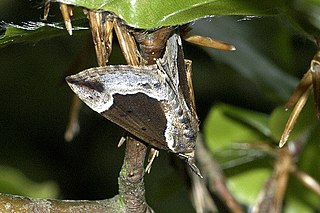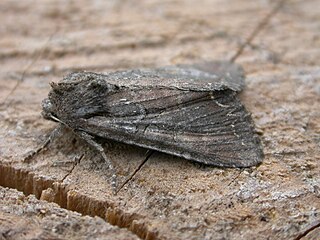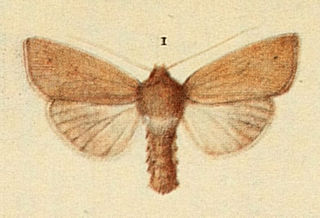
Mythimna impura, the smoky wainscot, is a moth of the family Noctuidae. The species was first described by Jacob Hübner in 1808. It is distributed throughout most of the Palearctic realm from Ireland in the west of Europe east to the Caucasus, Turkey, Syria, Kazakhstan, Russia, Siberia, Mongolia, then Japan. In Europe it is found from the Arctic Circle to Spain and Italy in the south, as well as in the northern regions of Greece.

Apamea monoglypha, the dark arches, is a moth of the family Noctuidae. The species was first described by Johann Siegfried Hufnagel in 1766. It is a common, sometimes abundant, European species. It is found in most of Europe except northernmost Fennoscandia and the southern parts of the Iberian Peninsula and Greece. The species is also found in Anatolia, Turkestan, Western Asia and Central Asia, Siberia and Mongolia. In the Alps it is found up to heights of 2,500 meters. The smaller subspecies sardoa is found on Sardinia and Corsica.

The Sprawler(Asteroscopus sphinx) is a moth of the family Noctuoidea. It is found throughout western Europe, but is mainly a Northern species occurring South to Northern Spain the southern edge of the Alps, Central Italy and Northern Greece. North to southern Sweden. East to Kaliningrad and Moscow. Also in Central Europe, Turkey, the Caucasus and Asia Minor.

Mormo maura, the old lady or black underwing, is a species of moth of the family Noctuidae. The species was first described by Carl Linnaeus in the 10th edition of his Systema Naturae. It is found in the Palearctic realm, from north-western Africa through all over southern Europe. It reaches its northern border in the west in northern Ireland and central Scotland, in central Europe, in northern Germany and Poland. In some Nordic countries, there are single finds. The other occurrence areas include Turkestan, Anatolia, the Middle East and Iraq. The name "old lady" refers to the fact that the wing pattern was said to resemble the shawls worn by elderly Victorian ladies.

Hypena crassalis, the beautiful snout, is a moth of the family Erebidae. The species was first described by Johan Christian Fabricius in 1787. It is found in Europe.

Fissipunctia ypsillon, the dingy shears, is a species of moth of the family Noctuidae. It is found in the Palearctic realm.

Tiliacea citrago, the orange sallow, is a species of moth of the family Noctuidae. It is found in Europe as far east as the Caucasus Mountains and the Urals.

Catocala sponsa, the dark crimson underwing, is a species of moth of the family Erebidae. It is found in Europe, North Africa and from Anatolia up to the Caucasus.

Lacanobia suasa, the dog’s tooth, is a moth of the family Noctuidae. It is found in the Palearctic realm.

Mythimna favicolor, or Mathew's wainscot, is a moth of the family Noctuidae. The species was first described by Charles Golding Barrett in 1896. It is found in Europe. The species is sometimes treated as a subspecies of Mythimna pallens, the common wainscot.

Mythimna obsoleta, the obscure wainscot, is a moth of the family Noctuidae. The species was first described by Jacob Hübner in 1803. It is found in Europe, from southern Fennoscandia to Spain, Italy and the Balkans, the European part of Russia, the Caucasus, Kazakhstan, Kyrgyzia, southern Siberia, Turkey, the Ural, Mongolia, the Russian Far East, the Korean Peninsula, China and Hokkaido and Honshu in Japan.

Chersotis multangula is a moth of the family Noctuidae. It is found in the mountainous areas of Central and Southern Europe, Morocco, Turkey, Armenia, Iran, Syria, Lebanon and the Caucasus.

Mesapamea secalis, the common rustic, is a moth of the family Noctuidae. The species was first described by Carl Linnaeus in his 1758 10th edition of Systema Naturae. It is found in Europe, north-west Africa, Turkey and northern Iran.

Globia algae, the rush wainscot, is a moth of the family Noctuidae. The species was first described by Eugenius Johann Christoph Esper in 1789. It is found in central and southern Europe, Turkey, Armenia, northern Caucasus, south-west Siberia.

Grammodes stolida, the geometrician, is a moth of the family Erebidae. The species was first described by Johan Christian Fabricius in 1775. It is found in Africa, southern Europe, most of Asia and Australia. It migrates to central and northern Europe as far north as England, Denmark and Finland.

The lesser-spotted pinion is a moth of the family Noctuidae. It is found in central and southern Europe, north to Great Britain, Denmark, southern Sweden up to Saint Petersburg. East, its range extends through northern and Central Asia up to Japan. It is also found in north-western Africa.

The silky wainscot is a moth of the family Noctuidae. It is found in most of Europe including Russia.

Denticucullus pygmina, the small wainscot, is a moth of the family Noctuidae. It is found in most of Europe, ranging from northern Spain, through Portugal as far north as Finland. In the east it is found across the Palearctic to the Russian Far East and western Siberia. It is also found in North Africa, Turkey, the Caucasus region and northern Iran.

The double-spot brocade is a species of moth of the family Noctuidae. It is found in most of Europe, in Turkey and the west of Iran. In Anatolia it is represented by the subspecies Meganephria bimaculosa pontica.

Lithophane furcifera, the conformist, is a moth of the family Noctuidae. The species was first described by Johann Siegfried Hufnagel in 1766. It is found from central Europe, east to the Black Sea region, the Caucasus and western Siberia. In the mountains, it is found up to elevations of 1,800 meters.




















